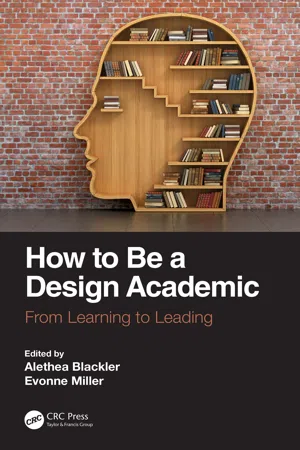1.1 Why Do You Need This Book?
This edited book offers an in-depth look into how design academics, from early career academics to full professors, navigate the changing and often turbulent waters of academia with confidence and impact. Being an academic, we believe, is one of the greatest jobs there is: as well as educating, influencing and mentoring undergraduate and postgraduate students through our teaching, we get to conduct innovative research that may have a positive impact on the world. Unfortunately, all too often, academics feel overburdened, tired, isolated and excessively busy, struggling to meet escalating performance metrics and be good teachers, productive researchers and efficient administrators (Clark and Sousa, 2018). There is often very little time to discuss, share and reflect on the strategies, ideas and initiatives that might enhance work productivity, reduce the likelihood of burnout and foster work–life balance, with only the lucky few having wise mentors to advise them.
Our vision for this book is that it fills this void, playing the role of a generous mentor and lifting back the veil to show, in detail, the day-to-day work lives, choices, challenges and achievements of design academics. By openly sharing their unique career paths, both conventional and unconventional, each chapter author provides unprecedented insight into their personal and professional experiences in academia. To date, despite the growing number of books exploring different aspects of academia, from how to complete a PhD (Mewburn, 2013), be a productive and “happy academic” (Clark and Sousa, 2018), thrive as a female professor (Murray and Mifsud, 2019) or negotiate the transition to retirement (Burge, 2015), to our knowledge, there are no books targeted specifically at design academics.
Design academics have a unique experience of academia for several reasons. Firstly, unlike most other disciplines, until very recently, it was rare for a design academic to hold a doctorate. A vocational field where professional practice is highly valued, design had a “history of a limited research culture, professional practice rather than research and few staff who are qualified at the doctoral level” (Durling, 2002, p. 80). Even in our own School of Design, where research is highly prized, approximately a third do not currently hold PhDs (ten years ago, that figure would have been 50%), and are completing their PhD while working as an academic. This is a uniquely challenging experience that Williams and Satherley explore in Chapter 5.
Secondly, by nature, design is a very experiential and practical discipline. Seen by practitioners as a process and seen by society as the result of or creations from that process, the word “design” has many different meanings. Design, Redström (2017) stated, is first of all a process, with Don Norman defining it as the “deliberate shaping of the environment in ways that satisfy individual and societal needs” (2009, p. 171). Design embraces a broad range of disciplines, including, but not limited to: architecture, industrial design, interior design, fashion design, interaction design, design management, design education, digital and visual communication and landscape architecture. What unifies these diverse disciplines is how they think and their approach to problem-solving: regardless of their specialist disciplinary training, designers share an iterative design process that privileges a unique way of problem-setting and problem-solving, often through visualisation and realisation (that is, making). While many of these skills are transferable to academia, as Swann and Rezayan document in their chapter on the new academic’s mindset, all too often, other skills (such as writing and conforming to traditional norms in academia) are harder for some to master.
And, like all academics, design academics must also learn how to navigate and negotiate the culture of academia – how to be great teachers and researchers, manage their own workloads, stay resilient, learn and evolve from early career academics into leadership roles. All universities have their own unique culture and ways of doing things, but typically, academics are expected to be independent and manage their own workload. Some design academics may be able to benefit from a supportive culture and colleagues and/or an engaged, hands-on line-manager, who provide advice, mentoring and clear direction. However, all too often, academia is a “sink-or-swim” culture, with very little tangible guidance for staff. This book is purposely written – in an accessible, conversational and informal style – to fill this gap and guide the reader through the challenging but highly rewarding career of being a design academic.
